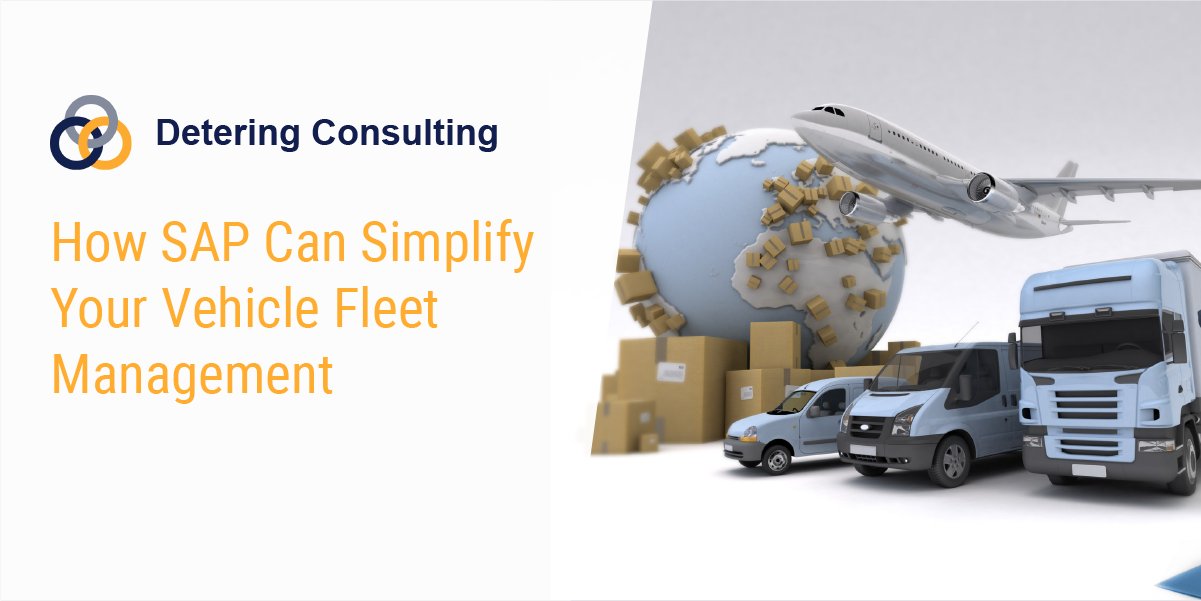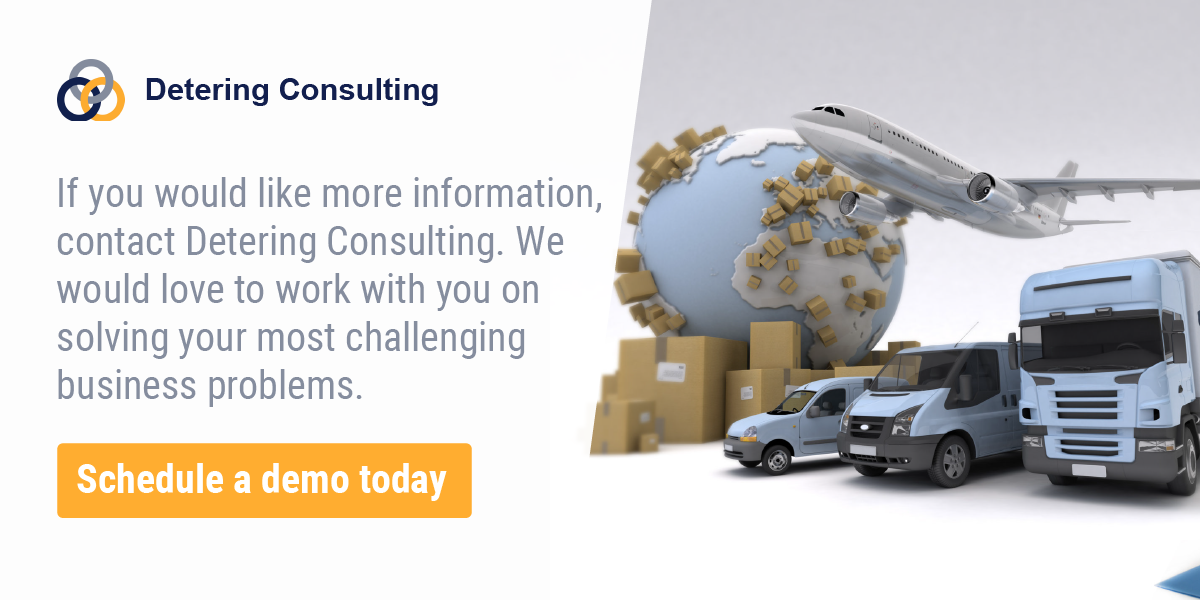You have a ship waiting to be unloaded, the crane is down, a few of the trucks are behind schedule, and your forklifts need maintenance.
Sound like a nightmare?
It would be without SAP. Luckily, with their vehicle fleet management system, with the SAP fleet management process flow, you can organize your fleet in real time, allow for delays, and keep track of essential fleet management data such as vehicle master data, vehicle number, product data, fuel consumption and maintenance schedules for each vehicle all in one place. SAP HANA also assists with finding the right vehicle for the right job. It does this by monitoring each vehicle's weight and volume capacity, so you know which ones to choose. The SAP Fleet Management Solution incorporates many best practices from the automotive industry as well as other manufacturing industries.
Not to be confused with the vehicle management system, which follows a vehicle's journey through the processes of its lifetime, vehicle fleet maintenance management keeps track of each vehicle in your fleet pool to ensure that each is performing at its peak and that coordination between vehicles is orchestrated seamlessly.

Vehicle Fleet Management Overview
Fleet management in SAP consists of entering vehicles as fleet objects in the system, which we will discuss further later on. Vehicle fleet management, including automobile fleet management, comes standard with the SAP program since they make all Customer Service (CS) and Plant Maintenance (PM) functions available to you. This includes:
- Executable programs (reports)
- List display
- List editing
- Maintenance history
- Plant Maintenance Information System (PMIS)
You can also use these as references for other maintenance or services tasks.
Fleet Objects to Consider
When considering fleet management, it’s easy to forget that fleets consist of more than cars and trucks. Fleets include commercial vehicles (forklifts, cranes, front-loaders, etc.), planes, trains, machinery, helicopters, ships, and buses, there are even fleet management for hospital scenarios, to name a few. Each of these types of vehicles is considered a fleet object. This means that fleet vehicles equate to equipment. Therefore, they can be recorded on an equipment master record, which provides specific data about each fleet object. This includes the typical equipment components for each vehicle as well as the following:
- Identification data: chassis number, license plate number
- Further attributes: fuel card number, key number
- Measurement data: height, width, volume
- Transport data: weight, maximum load weight, maximum load volume
- Engine Data: engine type, engine power, number of revolutions per minute, cubic capacity
- Fuel and lubrication data: fuel type, oil type
- Planning data: criteria for replacing fleet object
Even if you only use a single type of vehicle in your fleet pool, you can organize these into subsets for further evaluation. For example, if you only use freight vehicles, you can still categorize them by silo vehicles, dump trucks, tarpaulin-covered vehicles, etc.
To create a vehicle as equipment, go to Logistics > Plant Maintenance > Management of Technical Objects > Equipment > Create (Special) > Fleet Object.
Vehicle Fleet Management Prerequisites
To access fleet management, you must:
- Customize your settings. You can accomplish this under Plant Maintenance and Customer Service > Master Data in Plant Maintenance and Customer Service > Settings for Fleet Management. Doing this will help you differentiate between trucks, forklifts, cars, and other types of fleet vehicles.
- Organize the maintenance for each fleet object. You can do this by assigning an individual view profile for each fleet object type. This allows you to configure the screens of trucks, vans, and other types of vehicles differently. For example, vans might only be configured depending on their use, while trucks might be configured by load volume. The standard system allows for eight tab strips that you can arrange and label as you like.
- Create fleet objects as equipment. Then create vehicle counters and flags indicating they are consumption relevant.
- Create at least two documents for each vehicle. Do this during each calculation period to calculate the average daily performance for that vehicle.
Vehicle Fleet Management Features
Once you're set up, you're ready to take advantage of some of fleet management’s functions.
Connected Fleet
In the past, equipment managers had to input fleet object data manually. Within the healthcare industry, this was especially burdensome for healthcare companies. Healthcare workers have especially rigorous medical equipment fleet management tracking requirements and especially appreciate this functionality. The only other option was to purchase a GPS tracking system from a third party that could interface with SAP. Now, however, Connected Fleet can perform these functions for you directly through SAP.
Connected Fleet transmits data from sensors placed on each fleet object directly to a dashboard and the plant maintenance system. For example, Connected Fleet can monitor speed, wheel span, fuel usage, mileage, and warranty information. It can also watch the driver's and passengers' blood alcohol levels and heart rate to safeguard against health-related accidents.
You can also set conditions for data so that when vehicles reach a certain level, the system creates a maintenance plan. For example, when a vehicle runs for 3,000 miles, an oil change order will trigger. While this can be done by vehicle, several vehicles can be added to the maintenance order as needed.
In addition, if a vehicle goes off course or exceeds the maximum allowable speed, the system will send an alarm or email notification to the fleet manager.
In the short term, Connected Fleet can indicate potential theft if a vehicle appears in a non-approved area, takes an unfamiliar route, stops for an extended time, or exhibits non-regulated driving behavior.
The system can create a geofence or an area on a map where a vehicle must stay. If the vehicle goes outside the geofence, it triggers an alert that the driver is off course. This can be useful in planning the most effective routes and managing traffic in a busy fleet yard. In case of detours or road closures, it also helps dispatchers find alternate routes.
Individual vehicles also send metadata to the system, which then accesses the license number, driver, engine temperature, speed, and time since the last movement. These statistics allow dispatchers and fleet managers to warn tired drivers about potential dangers, such as overheating, if the driver doesn’t take action.
On shorter trips, fleet managers can decide that vehicle doors should not be opened during the trip for security reasons. If a door opens during that time, it could be a sign of trouble, such as a hijacking or flat tire.
Connected Fleet can also assess cargo temperature and humidity to determine if items are in danger of being harmed.
In the long term, Connected Fleet optimizes:
- Fleet health
- Predictive maintenance
- Utilization rates
- Route planning
- Delivery accuracy and timeliness
- Fuel consumption
The system also allows for comprehensive data collection and viewing to give easy access to information such as:
- Fleet summary including individual vehicle list
- Monitoring a specific vehicle group
- Event data, including vehicle and location
- View of vehicles and fleet on a map
- Trip lists by group or vehicle
- Trip details
Calculating Consumption Data
Improved Fleet Operations
With the right tools and customized settings under PM, fleet owners can calculate the consumption data of a fleet object in order to understand your fuel economy and focus on ways to lower your operating costs. To do this, you need a fuel counter to measure the amount of fuel or energy consumed. In addition, it would be best to have a primary or performance counter, which counts either a distance or time (such as a certain number of miles or hours on the road).
The following units of measurement are standard for calculating consumption:
- Liters per hour
- Liters per mile
- Liters per 100 kilometers
- Miles per gallon
Using the system’s calculation method, the data determined and displayed include:
- Total primary counter reading: from the last measurement document entered
- Total consumption-relevant fuel counter reading: from the last measurement document entered
- Average daily vehicle activity: using the fuel or energy counter, both long and short term (overall counter reading from the last measurement document – overall counter reading from the first measurement document)/number of days between the entry dates of both documents
- Average daily fuel consumption: using the primary counter, both long and short term (overall counter reading from the last measurement document – overall counter reading from the first measurement document)/number of days between the entry dates of both documents
- Next planned maintenance date: if you have a maintenance plan set
You define what is considered long and short term in customization. Having both of these periods available helps detect maintenance issues such as engine malfunctions, leaks, or operator misuse.
Master Data Maintenance
Master data maintenance relates directly to marine vessels. Fleet maintenance monitors each vessel's history and performance and schedules needed maintenance during available times, such as while the vessel is dry-docked.
The system also monitors voyage-related information such as the estimated time of arrival (ETA) and shipment data. Using this information, vehicle fleet management can monitor when a vessel is scheduled to depart, how long between services is optimal to maintain it in good repair, etc.
Vehicle Insights
Fleet Analytics Software
One of the tools SAP uses to monitor data is called Vehicle Insights. This is a cloud-based platform-as-a-service. It collects, stores, analyzes, and processes telemetry data.
This app aids in making business decisions and improving fleet performance. It collects data about vehicle wear and tear, maintenance, and driving habits which lowers the likelihood of a breakdown and decreases unnecessary downtime. Used alongside workshop management, you can almost completely automate your end-to-end vehicle maintenance process.
Vehicle Insights can be used from warehouse planning to international fleet management and is usable with any vehicle. It can also assist with business model creation and improve offered services.
In addition, the Vehicle Insights app will assist drivers in assigning themselves vehicles, writing notes about trips, etc. This app has two main features: My Vehicles and Driver Logbook.
My Vehicles applies to drivers who have private vehicles contracted to a business or vehicles that belong to the fleet. They can indicate whether they are still the driver of a vehicle and use the system to create vehicles, among other things.
Driver Logbook allows drivers to see the trips they logged on any vehicle using the My Vehicles app. The details view shows the relevant data collected. Drivers can also log a trip category such as private or business.
Fleet analysis manages costs, utilization, availability, and maintenance for whole fleets or fleet subsets through the Vehicle Insights app and business data and provides comprehensive truck fleet analytics. One of the main programs used in fleet analysis is the monitoring and tracking app. This app helps dispatchers and fleet managers monitor a vehicle's current and previous trips and related key performance indicators. For example, a map shows where a vehicle is and its route during a trip.
The standard data analytics view contains the key performance indicators you use to create reports and dashboards. In addition, SAP Analytics Cloud provides views that can be imported directly into the SAP BusinessObjects Cloud.
Under the standard view are three types of analytical data:
- Event analysis
- Fuel consumption analysis
- Fleet utilization
Event analysis analyzes events that happen to your vehicles, such as their previous locations and drivers.
As part of the fleet analytics function, the fuel consumption analysis examines how much fuel is consumed while driving and idling.
Fleet utilization gives data on the time and distance a vehicle has driven and the amount of time it has spent idling. Fuel consumption and fleet utilization can be analyzed by individual vehicles or by a group, such as the make and model of the vehicles.
Development Platform
Vehicle Insights can also be combined with the SAP Development Platform to create new apps. Together they can make apps for configuration, master data access, and analytics. First, however, keep in mind that you must design the app to consume the relevant API endpoints and use the information in the data access and analytics services.
You must use a third-party mapping service or create your own to build maps into your app.
These apps can analyze telemetry data from single vehicles to entire fleets across many different business scenarios, including:
- Remote vehicle diagnostics
- In-car services
- Commercial and corporate fleet management
- Mobility services
- Digital farming
Vehicles send telemetry data via a telemetry unit installed inside. This data is transformed into database tables by the message processor, which makes it available for analysis.
Manage Your Business Better with SAP
With SAP vehicle fleet maintenance and other functions, SAP makes managing your business a snap. Detering Consulting offers fleet management system implementation including fleet management data migrations, SAP Fleet Management design, configuration, testing and deployment for any size of organization. Our data migration service is just one of the critical capabilities we bring to the table to make your SAP Fleet Migration seamless.
If you would like more information, contact Detering Consulting. We would love to work with you on solving your most challenging business problems.

